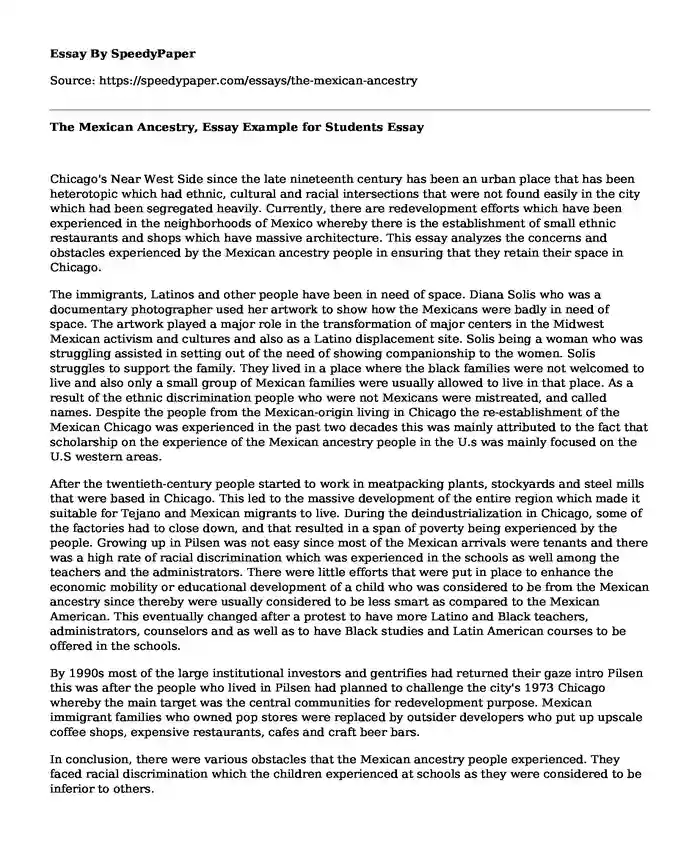
| Type of paper: | Essay |
| Categories: | Immigration |
| Pages: | 3 |
| Wordcount: | 555 words |
Chicago's Near West Side since the late nineteenth century has been an urban place that has been heterotopic which had ethnic, cultural and racial intersections that were not found easily in the city which had been segregated heavily. Currently, there are redevelopment efforts which have been experienced in the neighborhoods of Mexico whereby there is the establishment of small ethnic restaurants and shops which have massive architecture. This essay analyzes the concerns and obstacles experienced by the Mexican ancestry people in ensuring that they retain their space in Chicago.
The immigrants, Latinos and other people have been in need of space. Diana Solis who was a documentary photographer used her artwork to show how the Mexicans were badly in need of space. The artwork played a major role in the transformation of major centers in the Midwest Mexican activism and cultures and also as a Latino displacement site. Solis being a woman who was struggling assisted in setting out of the need of showing companionship to the women. Solis struggles to support the family. They lived in a place where the black families were not welcomed to live and also only a small group of Mexican families were usually allowed to live in that place. As a result of the ethnic discrimination people who were not Mexicans were mistreated, and called names. Despite the people from the Mexican-origin living in Chicago the re-establishment of the Mexican Chicago was experienced in the past two decades this was mainly attributed to the fact that scholarship on the experience of the Mexican ancestry people in the U.s was mainly focused on the U.S western areas.
After the twentieth-century people started to work in meatpacking plants, stockyards and steel mills that were based in Chicago. This led to the massive development of the entire region which made it suitable for Tejano and Mexican migrants to live. During the deindustrialization in Chicago, some of the factories had to close down, and that resulted in a span of poverty being experienced by the people. Growing up in Pilsen was not easy since most of the Mexican arrivals were tenants and there was a high rate of racial discrimination which was experienced in the schools as well among the teachers and the administrators. There were little efforts that were put in place to enhance the economic mobility or educational development of a child who was considered to be from the Mexican ancestry since thereby were usually considered to be less smart as compared to the Mexican American. This eventually changed after a protest to have more Latino and Black teachers, administrators, counselors and as well as to have Black studies and Latin American courses to be offered in the schools.
By 1990s most of the large institutional investors and gentrifies had returned their gaze intro Pilsen this was after the people who lived in Pilsen had planned to challenge the city's 1973 Chicago whereby the main target was the central communities for redevelopment purpose. Mexican immigrant families who owned pop stores were replaced by outsider developers who put up upscale coffee shops, expensive restaurants, cafes and craft beer bars.
In conclusion, there were various obstacles that the Mexican ancestry people experienced. They faced racial discrimination which the children experienced at schools as they were considered to be inferior to others.
Cite this page
The Mexican Ancestry, Essay Example for Students. (2022, Apr 15). Retrieved from https://speedypaper.net/essays/the-mexican-ancestry
Request Removal
If you are the original author of this essay and no longer wish to have it published on the SpeedyPaper website, please click below to request its removal:
- Free Essay Sample on Open Source Licensing
- Essay Sample on San Francisco Homeless Problem
- Free Essay about Visiting the Detroit Institute of Art
- Ethical Police Administration, Essay Example for Students
- Paper Example on Billing and Reimbursement in St Joseph Hospital
- Free Essay Example. Ross Inc Financial Analysis
- American Philosophy Answer Assignment - Essay Sample
Popular categories




